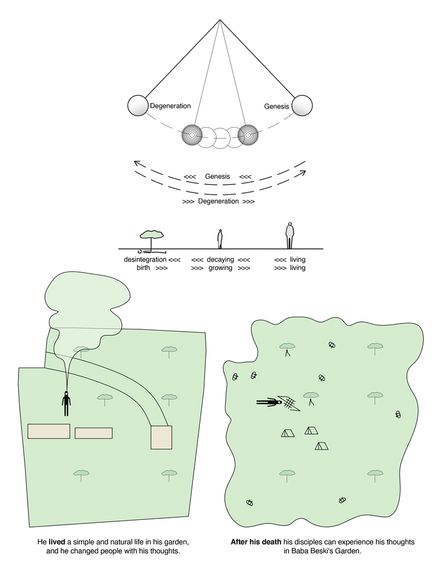
Baba Beski’s Tomb
PHOTOGRAPHS
Soroush Majidi, Faezeh Kaboli, Aran Mohiedin, Nazanin Zakeri, Fateme Rezaei
YEAR
2020
LEAD ARCHITECTS
Mohammadreza Ghodousi, Fateme Rezaei, Golnaz Bahrami, Fereshteh Assadzadeh
GRAPHIC & ILLUSTRATION
Fereshteh Assadzade
SUPERVISION
Fateme Rezaei, Sheila Ehsaei
CLIENT
Khalil Farshbaf- Beski Family
DESIGN TEAM
Shila Ehsaie, Sara Jafari, Mohsen Safshekan
STURCTURE ENGINEER
Behrang Baniadam
LOCATION
Golestān, Iran
CONSTRUCTION
Khalil Farshbaf
COLLABORATOR
Sabzgaman Beski
He spent his days in a large natural private garden in the North of Iran, where he hosted his many visitors and friends.
After his death, his body was buried there according to his will. Beski’s immediate family did not settle on merely executing his will, and the idea was put forward to make the garden a semi-public place of rest and reflection for his many followers.
In this way, his tomb had to be capable to extend from a limited physical point to an idea filling an entire garden.
Beski’s body is buried next to the spaces of his everyday living. He is thought to be perished but he is also growing into the living texture of vegetation that make the garden be.
Whatever is born is subject to decay, and whatever decays is the basis for a new reproduction.
There is practically no absolute moment of completeness or nothingness, and the intermediate state of incompleteness is the dominant state in the cycle of life.
This vicinity of life and death, this entanglement of two seemingly but not necessarily opposite concepts, is what interested the designers.
In the design process, the state of incompleteness is embraced as the ultimate state of being. To make it visible, man-made structures and the natural texture of the garden are suspended in an intermingling limbo of incompleteness, between death and life, therefore insisting on the perpetual cycle of genesis and degeneration.
The monument of Beski consists of a structure made of woven rebar, conventionally used as the tensile element of reinforced concrete and normally considered unfinished, awaiting its completion.
The structure seems unstable at first glance, especially because its two thin standing planes of rebar have an angled position.
There is a structural reason behind this Structure Wise: the two planes compensate their lateral forces horizontally while supporting the top covering vertically.
As a result, the footprint of the structure has been minimized to two thin baselines, and its appearance displays instability, incompleteness, and spacelessness.
Later on, the structure rusts over time and is covered in and taken over by climbing plants.
This was the first phase of Baba Beski’s garden turning into a public garden, next phase of the project includes rebirthing his living spaces to the public sphere has designed under the same umbrella concept and will execute next year.






























